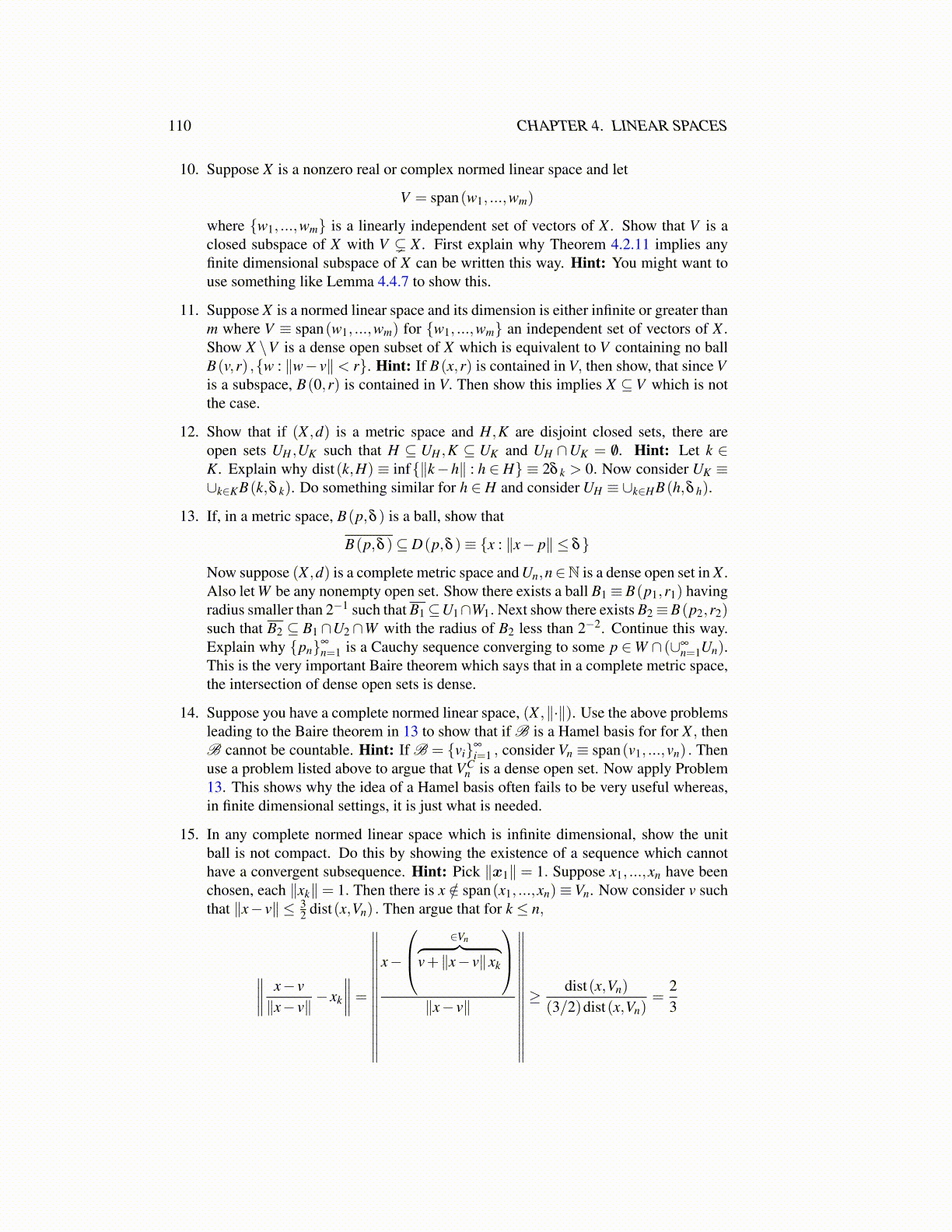
110 CHAPTER 4. LINEAR SPACES
10. Suppose X is a nonzero real or complex normed linear space and let
V = span(w1, ...,wm)
where {w1, ...,wm} is a linearly independent set of vectors of X . Show that V is aclosed subspace of X with V ⊊ X . First explain why Theorem 4.2.11 implies anyfinite dimensional subspace of X can be written this way. Hint: You might want touse something like Lemma 4.4.7 to show this.
11. Suppose X is a normed linear space and its dimension is either infinite or greater thanm where V ≡ span(w1, ...,wm) for {w1, ...,wm} an independent set of vectors of X .Show X \V is a dense open subset of X which is equivalent to V containing no ballB(v,r) ,{w : ∥w− v∥< r}. Hint: If B(x,r) is contained in V, then show, that since Vis a subspace, B(0,r) is contained in V. Then show this implies X ⊆ V which is notthe case.
12. Show that if (X ,d) is a metric space and H,K are disjoint closed sets, there areopen sets UH ,UK such that H ⊆ UH ,K ⊆ UK and UH ∩UK = /0. Hint: Let k ∈K. Explain why dist(k,H) ≡ inf{∥k−h∥ : h ∈ H} ≡ 2δ k > 0. Now consider UK ≡∪k∈KB(k,δ k). Do something similar for h ∈ H and consider UH ≡ ∪k∈HB(h,δ h).
13. If, in a metric space, B(p,δ ) is a ball, show that
B(p,δ )⊆ D(p,δ )≡ {x : ∥x− p∥ ≤ δ}
Now suppose (X ,d) is a complete metric space and Un,n∈N is a dense open set in X .Also let W be any nonempty open set. Show there exists a ball B1 ≡ B(p1,r1) havingradius smaller than 2−1 such that B1⊆U1∩W1. Next show there exists B2≡B(p2,r2)such that B2 ⊆ B1 ∩U2 ∩W with the radius of B2 less than 2−2. Continue this way.Explain why {pn}∞
n=1 is a Cauchy sequence converging to some p ∈W ∩ (∪∞n=1Un).
This is the very important Baire theorem which says that in a complete metric space,the intersection of dense open sets is dense.
14. Suppose you have a complete normed linear space, (X ,∥·∥). Use the above problemsleading to the Baire theorem in 13 to show that if B is a Hamel basis for for X , thenB cannot be countable. Hint: If B = {vi}∞
i=1 , consider Vn ≡ span(v1, ...,vn) . Thenuse a problem listed above to argue that VC
n is a dense open set. Now apply Problem13. This shows why the idea of a Hamel basis often fails to be very useful whereas,in finite dimensional settings, it is just what is needed.
15. In any complete normed linear space which is infinite dimensional, show the unitball is not compact. Do this by showing the existence of a sequence which cannothave a convergent subsequence. Hint: Pick ∥x1∥ = 1. Suppose x1, ...,xn have beenchosen, each ∥xk∥= 1. Then there is x /∈ span(x1, ...,xn)≡Vn. Now consider v suchthat ∥x− v∥ ≤ 3
2 dist(x,Vn) . Then argue that for k ≤ n,
∥∥∥∥ x− v∥x− v∥
− xk
∥∥∥∥=∥∥∥∥∥∥∥∥∥∥∥∥∥∥
x−
∈Vn︷ ︸︸ ︷v+∥x− v∥xk
∥x− v∥
∥∥∥∥∥∥∥∥∥∥∥∥∥∥≥ dist(x,Vn)
(3/2)dist(x,Vn)=
23